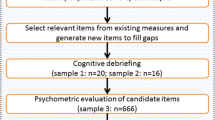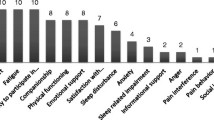Abstract
Health-related quality of life (QoL) questionnaires are commonly developed as content valid instruments with conventionally defined domain subscales. We contrasted content valid domain subscales with construct valid construct subscales and developed a 13-domain QoL questionnaire, the Breathing Problems Questionnaire (BPQ), for patients with chronic bronchitis. In a series of studies, we examined the constructs relevant to COPD patients' experience of health. First, we provided psychometric evidence that items in the BPQ form two distinct groups: functional problems and negative evaluations. Second, we showed that problems were significantly more correlated with morbidity whereas negative evaluations were significantly more correlated with neuroticism. Third, we showed that negative evaluations correlated with neuroticism whereas positive evaluations (measured by the Satisfaction with Illness Scale) correlated with extraversion. Patients are more likely to make positive evaluations of their Illness when they recognize that they are seriously ill. Most of the BPQ domains are subcategories of the construct of problems: both domains and construct classifications provide useful information.
Similar content being viewed by others
References
Ware JE. Standards for validating health measures: definition and content. J Chronic Dis 1987; 40: 473–480.
Spilker B. Introduction. In: Spilker B, ed. Quality of Life Assessment in Clinical Trials. New York: Raven Press, 1990: 3–9.
Bergner M, Bobbit RA, Carter WB, Gilson BS. The Sickness Impact Profile: Development and final revision of a health status measure. Med Care 1981; 19: 787–805.
Ware JE, Sherbourne CD. The MOS 36-Item Short-Form Health Survey (SF-36). Med Care 1992; 30: 473–483.
Hunt SM, McEwen J, McKenna S. Measuring Health Status. London: Croom Helm, 1986.
Kaplan RM, Bush JW. Health-related quality of life measurement for evaluation of research and policy analysis. Health Psychol 1982; 1: 61–80.
Hyland ME. Selection of items and avoidance of bias in quality of life scales. PharmacoEcon 1992; 1: 182–190.
Jones PW, Quirk FH, Baveystock CM, Littlejohns P. A self-complete measure for chronic airflow limitation — the St George's Respiratory Questionnaire. Am Rev Resp Dis 1992; 145: 1321–1327.
Juniper EF, Guyatt GH, Epstein RS, Ferrie PJ, Jaeschke R, Hiller TK. Evaluation of impairment of health related quality of life in asthma: development of a questionnaire for use in clinical trials. Thorax 1992; 47: 76–83.
Anastasi A. Psychological Testing (6th edn.). New York: Collier Macmillan, 1988.
Hyland ME. A reformulation of quality of life for medical science. Qual Life Res 1992; 1: 267–272.
Diener E. Subjective well-being. Psychol Bull 1984; 95: 542–575.
Lazarus RS, Folkman S. Stress, Evaluations, and Coping. New York: Springer, 1984.
Lazarus RS. Thoughts on the relations between emotion and cognition. Am Psychol 1982; 36: 1019–1024.
LeDoux JL. Cognitive-emotional interactions in the brain. Cognition Emotion 1989; 3: 267–289.
Lazarus RS, Smith CA. Problems and evaluations in the cognition-emotion relationship. Cognition Emotion 1988; 2: 281–300.
Guyatt GH, Berman LB, Townsend M, Pugsley SO, Chambers LW. A measure of quality of life for clinical trials in chronic lung disease. Thorax 1987; 42: 773–778.
Rosser RM, Watts VC. The measurement of hospital output. Int J Epidemiol 1972; 1: 361–368.
Gudex C, Kind P. The QALY toolkit: Centre for Health Economics Discussion Paper 38. York, UK: University of York, 1988.
Fernandez E, Turk DC. Sensory and affective components of pain: Separation and synthesis. Psychol Bull 1992; 112: 205–217.
McHorney CA, Ware JE, Raczek AE. The MOS 36 Item Short-Form Health Survey (SF-36).2. Psychometric and clinical tests of validity in measuring physical and mental health constructs. Clin Care 1993; 31: 247–263.
Bradburn NM. The Structure of Psychological Wellbeing. Chicago: Aldine, 1969.
Costa PT, McCrae RR. Influence of extraversion and neuroticism on subjective well-being: happy and unhappy people. J Pers Soc Psychol 1980; 38: 668–678.
Izard CE, Libero DZ, Putnam P, Haynes OM. Stability of emotion experiences and their relation to traits of personality. J Pers Soc Psychol 1993; 64: 847–860.
Watson D. Intraindividual and interindividual analysis of positive and negative affect: their relation to health complaints, perceived stress, and daily activities. J Pers Soc Psychol 1988; 54: 1020–1030.
Watson D. The vicissitudes of mood measurement: effects of varying descriptors, time frames, and response formats on measures of positive and negative affect. J Pers Soc Psychol 1988; 55: 128–141.
Watson D, Clark LA, McIntyre CW, Hamaker S. Affect, personality and social activity. J Pers Soc Psychol 1992; 63: 1011–1025.
Brief AP, Butcher AH, George JM, Link KE. Integrating bottom-up and top-down theories of subjective well-being: the case of health. J Pers Soc Psychol 1993; 64: 646–653.
Heady B, Wearing A. Personality, life events, and subjective well-being: Toward a dynamic equilibrium model. J Pers Soc Psychol 1989; 57: 731–739.
Pavot W, Diener E, Fujita F. Extraversion and happiness. Pers Indiv Diff 1990; 11: 1299–1306.
Seidlitz L, Diener E. Memory for positive versus negative life events: Theories for the differences between happy and unhappy persons. J Pers Soc Psychol 1993; 64: 654–664.
Jones PW, Baveystock CM, Littlejohns P. Relationships between general health measured with the Sickness Impact Profile and respiratory symptoms, physiological measures, and mood in patients with chronic airflow limitation. Am Rev Resp Dis 1989; 140; 1538–1543.
Zigmund AS, Snaith RP. The hospital anxiety and depression scale. Acta Psychiatr Scand 1983; 67: 361–370.
Hyland ME, Kenyon CAP: A measure of positive health-related quality of life: the Satisfaction with Illness Scale. Psychol Rep 1992; 71: 1137–1138.
Csikszentmihalyi M. Flow: the Psychology of Happiness. London: Rider, 1992.
Evans RW. Quality of life. Lancet 1991; 338: 363.
Creer TL. Asthma. J Consult Clin Psychol 1982; 50: 912–921.
Gustafsson PA, Kjellman NIM, Cederblad M. Family therapy in the treatment of severe childhood asthma. J Psychosom Res 1986; 30: 369–374.
McSweeny AJ, Labuhn KT. Chronic obstructive pulmonary disease. In: Spilker B, ed. Quality of Life Assessments in Clinical Trials. New York: Raven, 1990: 391–417.
Williams SJ. Chronic Respiratory Illness. London: Routledge, 1993.
Hyland ME, Bott J. Excretion urgency in chronic obstructive pulmonary disease. Lancet 1992; 339: 1121.
Hyland ME, Finnis S, Irvine SH. A Scale for assessing quality of life in adult asthma sufferers. J Psychosom Res 1991; 35: 99–110.
Lance CE, Lautenschlager GJ, Sloan CE, Varca PE. A comparison between bottom-up, top-down, and bidirectional models of relationships between global and life facet satisfaction. J Pers 1989; 57: 601–624.
Eysenck HJ, Eysenck SBG, Manual of the Eysenck Personality Scales. London: Hodder and Stoughton, 1991.
Diener W, Emmons RA, Larsen R, Griffin S. The Satisfaction with Life Scale. J Pers Assess 1989; 49: 71–75.
Pavot W, Diener E, Colvin CR, Sandvik E. Further validation of the Satisfaction with Life Scale: evidence for the cross-method convergence of wellbeing measures. J Pers Assess 1991; 57: 149–161.
Swinburn CR, Wakefield JM, Jones PW. Performance, ventilation and oxygen consumption in three different types of exercise tests in patients with chronic obstructive lung disease. Thorax 1985; 40: 581–586.
Singh SJ, Hardman AE, Bardsley PA, Morgan MDL. A comparison of patients' performance on the Shuttle Walking Test and maximal oxygen uptake in patients with chronic airways limitation. Am Rev Resp Dis 1992; 145: 765A.
Singh SJ, Morgan MDL, Scott S, Walters D, Hardman AE. Development of Shuttle Walking Test of disability in patients with chronic airflow obstruction. Thorax 1992; 47: 1019–1024.
Curtis JR, Deyo RA, Hudson LD. Health-related quality of life among patients with chronic obstructive pulmonary disease. Thorax 1994; 49: 162–170.
Eakin EG, Kaplan RM, Rise AL. Measurement of dyspnoea in chronic obstructive pulmonary disease. Qual Life Res 1993; 2: 181–191.
Author information
Authors and Affiliations
Rights and permissions
About this article
Cite this article
Hyland, M.E., Bott, J., Singh, S. et al. Domains, constructs and the development of the breathing problems questionnaire. Qual Life Res 3, 245–256 (1994). https://doi.org/10.1007/BF00434898
Received:
Accepted:
Issue Date:
DOI: https://doi.org/10.1007/BF00434898




